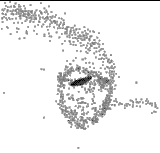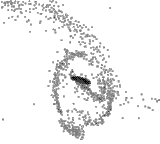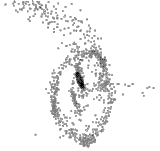


1.1. Towards a Model of the Antennae
The Antennae galaxies (NGC 4038 / 9) are fast becoming the ``Rosetta
stone'' of interacting systems; detailed observations in almost every
waveband from 21 cm to X-rays provide a remarkably complete
picture of the behavior of interstellar material and star formation in
the earlier stages of a galactic merger. These galaxies have also
long been a favorite of N-body experimenters. But until recently, the
available line-of-sight velocity data were not good enough to support
detailed simulations. New VLA observations (Hibbard, van der Hulst,
& Barnes, in preparation) offer the chance to refine existing models.
Goals for an improved model of the Antennae include:
Matching the observed velocity field. The radial
velocities of
the two galaxies differ by only ~ 40 km sec-1. To
produce this, the galaxies must either be near apocenter, or falling
together almost perpendicular to our line-of-sight.
Reconciling the adopted orbit with cosmological
expectations. Simulations by
Toomre & Toomre (1972)
and Barnes (1988)
adopted elliptical (e  0.6)
orbits; parabolic orbits seem more plausible.
0.6)
orbits; parabolic orbits seem more plausible.
Reproducing the gas-rich ring in NGC 4038. This
ring, clearly seen in maps of HI as well as in mid-IR
(Mirabel et al. 1998),
contains many luminous young star clusters
(Whitmore & Schweizer
1995).
Explaining the ``overlap region''. Recent ISO
maps show this dusty region is brighter than either disk in mid-IR
wavebands (eg.,
Mirabel et al. 1998).
Goals one and two involve adjusting the orbit, the viewing angle, and
the orientations of the two disks. To rapidly explore this vast
parameter space, I run ``semi-consistent'' simulations in which each
galaxy is represented by a self-gravitating spheroid with a number of
embedded test particle disks; the two disks best matching the
observations are selected interactively after the calculation has run.
Starting with orbits as eccentric as e = 0.8, this technique yields
models which roughly reproduce the velocity field as well as the
crossed-tail morphology of NGC 4038 / 9. But still less than
satisfactory are the shapes of the gently curving tails and the
orientations of their parenting disks; experiments are under way to
study these problems and make models with parabolic initial orbits.
Goals three and four depend on gas dynamics. In high-resolution HI
maps, gas in the southern tail seems to join continuously onto the
ring in NGC 4038. Rings of similar size and morphology may
arise as a
result of gas falling back along tidal tails; the formation of such a
ring is illustrated in Figure 1. Simulations of the
Antennae reproducing this feature might shed some light on the
conditions of star-formation in this system. Perhaps more challenging
is to account for the IR-luminous overlap region. This seems to be
more than just the superposition of two disks; it is probably some
sort of bridge, perhaps extended along the line of sight.



 0.6)
orbits; parabolic orbits seem more plausible.
0.6)
orbits; parabolic orbits seem more plausible.







